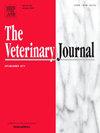Nucleic acid amplification–lateral flow immunoassay (NAA-LFIA) for the rapid differentiation of Trypanosoma evansi and Trypanosoma equiperdum
IF 2.3
2区 农林科学
Q1 VETERINARY SCIENCES
引用次数: 0
Abstract
Trypanosoma evansi and Trypanosoma equiperdum are very difficult to distinguish morphologically. However, molecular identification algorithms sequentially using Mini and Maxi primers can distinguish the two species. Duplex polymerase chain reaction (dPCR) facilitates simultaneous amplification but is difficult to visualize with gel electrophoresis because it produces overlapping amplicons. Meanwhile, recombinase polymerase amplification (RPA) samples using two pairs of primers must be incubated separately due to differences in incubation temperature. This study aimed to evaluate the initial use of duplex lateral flow immunoassay (dLFIA) to distinguish T. evansi and T. equiperdum. The dPCR was performed by mixing two pairs of primers with the DNA template in one master mix tube, while for RPA, the Mini primer was incubated at 40 °C for 30 minutes and the Maxi at 42 °C for 60 minutes. The dPCR product was diluted and dropped onto the sample pad of dLFIA, while the RPA products were diluted and mixed before being dropped onto the sample pad. The results showed that dPCR had a limit of detection for nucleic acids of 102 trypanosomes/mL, while that of RPA was only 103 trypanosomes/mL. The highest agreement coefficient for trypanosome detection between dPCR-dLFIA and RPA-dLFIA was 0.875, while that for trypanosome identification and differentiation was 0.571. dLFIA revealed separate bands of the two amplicons from dPCR using Mini and Maxi primers, unlike agarose gel electrophoresis. Thus, dPCR-dLFIA successfully identified T. evansi and T. equiperdum. On the other hand, RPA-dLFIA needs further improvement to reduce species misidentification and increase its agreement with dPCR-dLFIA.
求助全文
约1分钟内获得全文
求助全文
来源期刊

Veterinary journal
农林科学-兽医学
CiteScore
4.10
自引率
4.50%
发文量
79
审稿时长
40 days
期刊介绍:
The Veterinary Journal (established 1875) publishes worldwide contributions on all aspects of veterinary science and its related subjects. It provides regular book reviews and a short communications section. The journal regularly commissions topical reviews and commentaries on features of major importance. Research areas include infectious diseases, applied biochemistry, parasitology, endocrinology, microbiology, immunology, pathology, pharmacology, physiology, molecular biology, immunogenetics, surgery, ophthalmology, dermatology and oncology.
 求助内容:
求助内容: 应助结果提醒方式:
应助结果提醒方式:


